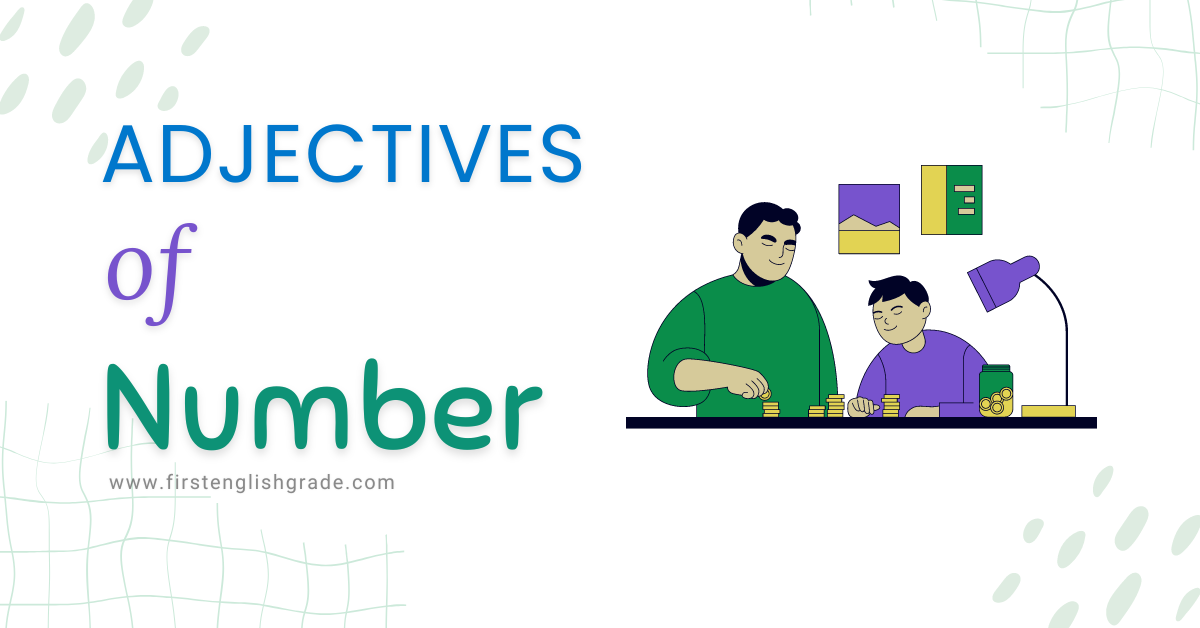Imagine you’re at a pizza party with your friends, and everyone is excited to grab a slice. But how do you ask for your share? You could simply say, ‘I want pizza,’ but to be more precise, you might say, ‘I want three slices of pizza.’ That’s where adjectives of number come into play. They help us specify and quantify things.
Let’s explore everything about adjectives of number, and learn how they are used in various real-life situations.
What Are Adjectives of Number?
Adjectives of number are a fundamental part of English grammar that help you describe the quantity or number of items, people, or things in a sentence. They answer the question, “How many?” and enable us to specify a precise quantity, provide an approximation, or emphasize individuality within a group. Adjectives of number examples are one, two, some, few, each, etc. These little words play a big role in describing quantities, order, and repetition in English.
Types of Adjectives of Number
Adjectives of number come in different kinds, each serving a specific purpose in making our communication more precise. Let’s take a closer look at these types and how they help us convey information effectively.
Types of Adjectives of Number
| Type | Purpose | Example |
| Cardinal | Indicate quantity | Five apples |
| Ordinal | Indicate order | The first place |
| Multiplicative | Show repetition or multiplication | Twice as fast |
Cardinal Adjectives
Cardinal adjectives tell us “how many.” They answer questions like “how many apples?” or “how much sugar?” Cardinal adjectives can express any number, from one to infinity, making them very flexible in everyday conversations. Whether you’re counting apples, describing ages, or noting the number of friends at a party, cardinal adjectives are your go-to choice for precision.
Examples:
- I have seven books on my shelf.
In this case, “seven” is the cardinal adjective that tells us exactly how many books there are. It’s your go-to choice when you want to count things.
- There are ten students in our science class.
Here, “ten” gives us a clear picture of the quantity of students in the class. It helps us understand the size of the group.
Ordinal Adjectives
Ordinal adjectives play a unique role in English by indicating the order or position of items in a sequence. Instead of telling us “how many,” they answer the question “in which order?” Ordinal adjectives help us to express preferences, rankings, and information about order or sequence. They tell us which item comes first, second, third, and so on.
Examples:
- The first place: When you want to emphasize that someone or something is in the top position, you use the ordinal adjective “first.” For instance, in a race, the winner occupies the first place.
- The third chapter: If you’re reading a book, “the third chapter” refers to the chapter that comes after the first and second ones. Ordinal adjectives help you describe the order of chapters, events, or elements in a series.
- My younger brother is the second child in our family: Here, “the second” is used to explain the order in which siblings were born. It clarifies that there’s an older sibling before “the second” child.
Example Sentences:
- Who won the first prize in the race?
- The third chapter of this history book is my favorite.
Common Ordinal Adjectives
| Number | Ordinal Adjective |
| One | First |
| Two | Second |
| Three | Third |
| Four | Fourth |
| Five | Fifth |
| Six | Sixth |
| Seven | Seventh |
| Eight | Eighth |
| Nine | Ninth |
| Ten | Tenth |
Multiplicative Adjectives
Multiplicative adjectives are a distinct category of adjectives of number. They are used to indicate repetition, multiplication, or how many times something occurs. These adjectives help you provide a more detailed account of quantity or frequency.
Examples:
- The cheetah runs twice as fast as the lion: In this sentence, “twice” is a multiplicative adjective that tells us how many times faster the cheetah runs compared to the lion. It adds a layer of precision to the description.
- I need to study three times harder for the exam: Here, “three times” emphasizes the increased effort needed for studying. It highlights the intensity or frequency of the action.
- She called me four times yesterday: The multiplicative adjective “four times” specifies the number of times someone made a phone call. It clarifies the frequency of the action.
Common Multiplicative Adjectives
| Number | Multiplicative Adjective |
| One | Once |
| Two | Twice |
| Three | Thrice |
| Four | Four times |
| Five | Five times |
| Six | Six times |
| Seven | Seven times |
| Eight | Eight times |
| Nine | Nine times |
| Ten | Ten times |
Common Mistakes and Pitfalls
Adjectives of number are powerful tools for describing quantity, order, and repetition. However, they can be a source of confusion if not used correctly. Here are some common mistakes and pitfalls to avoid when working with adjectives of number:
1. Misplacing the Adjective:
Incorrect: “The kid wants to buy delicious three cupcakes.”
Correct: “The kid wants to buy three delicious cupcakes.”
In the incorrect example, the order of adjectives is incorrect. Adjectives in English generally follow a specific order when used together before a noun. The correct order is typically: quantity, opinion, size, age, shape, color, origin, material, and purpose. In this case, “three” (quantity) should come before “delicious” (opinion).
2. Using Cardinal Numbers for Order:
Incorrect: “She is the four sister.”
Correct: “She is the fourth sister.”
In the incorrect example, “four” is used to indicate the order of the sister, which is incorrect. When expressing order, use ordinal adjectives like “fourth” instead of cardinal numbers like “four.”
3. Neglecting Agreement:
In English, adjectives of number should agree with the noun they modify. This means that the form of the adjective should match the form of the noun in terms of number (singular or plural). Here’s a breakdown:
- If the noun is singular, use a singular form of the adjective. For example: “A woman is sitting in the car.” (Here, “woman” is singular, and “a” is used with the singular noun.)
- If the noun is plural, use a plural form of the adjective. For example: “Cats are sleeping on the chair.” (Here, “cats” is plural, and “are” is used with the plural noun.)
Real-World Applications – Adjective of Number Examples
Adjectives of number are not just abstract grammar rules; they are essential for effective communication in real-life scenarios. Let’s explore some common situations where you’ll encounter these adjectives:
1. Shopping:
Imagine you’re at a store or market, and you want to buy items. Adjectives of number help you specify the quantity you need. For instance:
- “I’d like to purchase three green apples and two ripe bananas, please.”
- “I need five meters of colorful ribbon for a gift.”
In these situations, cardinal adjectives like “three,” “two,” and “five” help you communicate your exact requirements to the shopkeeper.
2. Travel and Transportation:
When planning your travels, adjectives of number come in handy for booking tickets, reserving seats, or discussing transportation options:
- “I’d like to book two seats on the next flight to New York.”
- “We have four boys traveling in the car with us.”
- “The fifth bus from the station will take you downtown.”
These examples show how ordinal adjectives like “two,” “four,” and “fifth” assist in specifying the order or quantity of travelers and transport options.
3. Cooking and Recipes:
In the kitchen, adjectives of number are indispensable for following recipes and preparing delicious meals:
- “Let the dough rise for three hours.”
- “The recipe calls for four cloves of garlic.”
Here, cardinal adjectives help you measure ingredients accurately and ensure your culinary creations turn out just right.
4. Social Gatherings:
When organizing or attending social events, adjectives of number help with guest counts, seating arrangements, and more:
- “We’re expecting ten guests at our dinner party this Sunday.”
- “There are three tables set up for the event.”
- “Please make reservations for two at 7:30 PM tomorrow.”
In these contexts, cardinal adjectives assist in managing gatherings and ensuring everyone is accommodated comfortably.
5. Academic and Professional Situations:
In educational or workplace settings, adjectives of number are crucial for discussing class sizes, employee counts, and project specifications:
- “Our class has twenty students this semester.”
- “The department is comprised of six talented professionals.”
- “We aim to complete eight tasks by the end of the week.”
These examples demonstrate how cardinal adjectives facilitate discussions involving quantities and numbers in academic and professional contexts.
Summary
Adjectives of number add depth and precision to your sentences, allowing you to convey numerical information accurately. They play a crucial role in everyday communication, whether you’re talking about the number of books on a shelf, estimating the size of a crowd, or emphasizing that each item in a collection is unique.




